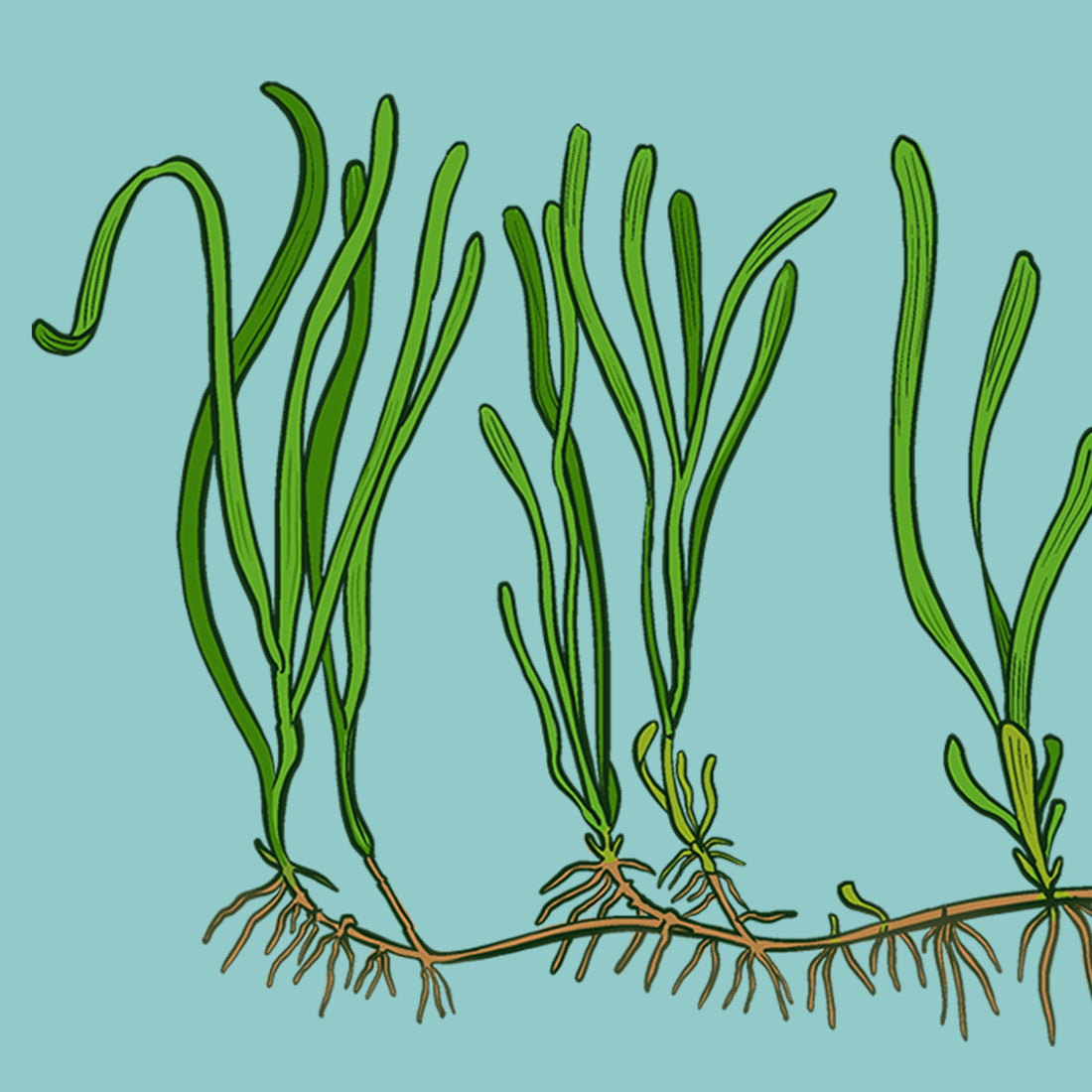
The Everlasting Magic of Eelgrass
Share
By Alexandra Vance, M.M.M., B.Sc.
March 2023
Lying just beneath the ocean’s surface you can find long strands of emerald green ribbons swaying in cool, calm waters. While you might not think much of these submerged grasses at first, these belong to the only family of marine flowering plants ever discovered and are the key to healthy and abundant coastal ecosystems around the world. Eelgrass is one of the most fascinating and far-ranging species of marine plants there is, providing food, shelter, and nurseries to all kinds of animals. Plus, it creates oxygen, filters and cleans the water, prevents coastal erosion, engineers new habitat types, plus it’s one of the planet’s secret weapons against climate change. All the while looking so serene as it gently sways with tides. Let’s take a deep dive into this shallow water keystone species.
Before we get too deep into the magic of eelgrass and its family, I should preface that I am enamored by this coastal species. So much so that I chose to write my Master’s of Marine Management thesis on the integrated coastal and ocean benefits and stressors on eelgrass, with a local focus on meadows along my home province of New Brunswick, Canada. I grew up playing in the intertidal zone with my friends and neighbors; we pretended to be marine biologists and did our best to identify every species we came across. Needless to say, these experiences had a lasting effect on me! It wasn’t until I was almost done my undergraduate degree that I had a life-changing eureka moment, and decided to switch my attention from microbiology to oceanography. Instead of placing so much emphasis on the small, I wanted to understand the big – the interconnected, symbiotic relationships that happen at the ecosystem scale. When I started to consider which species have the biggest influence on coastal and ocean ecosystems, I found myself full circle staring back at the ‘gorgeous green ocean grass’, as we used to call it when we were kids. I haven’t looked back since!

Let’s start at the beginning. First, you should know that eelgrass (Zostera marina) is one of the 72 species of seagrasses, the family of the only flowering plants known to exist. Eelgrass is a temperate species, and the only subspecies found along the North Atlantic coastlines of Canada, US, and the UK. They evolved from terrestrial plants about 100 million years ago, and would have been closely related to grasses until they adapted to live out their entire life cycles submerged in marine environments. When you consider that all other marine vegetation is algae, this is a pretty impressive fact! Just like their terrestrial ancestors, seagrasses rely on pollination for their sexual reproduction, using both currents and critters (like crabs and worms) to help them disperse their pollen far and wide. And like all vegetation, they use photosynthesis to create oxygen, and through their respiration process also filter out some pollutants from the water to help make the ocean overall more clean and healthy[1].
A unique distinction between seagrasses and algaes is that while algaes will attach to a hard substrate using holdfasts, seagrasses have roots that burrow down into the sediment – just like they would on land. The plants grow in all directions; while the fronds shoot upwards and the roots grow down, seagrasses also send out rhizomes (like strawberries!) that spread out to elongate their root structures and help them create large meadows. This is also part of their asexual reproduction strategy, where they clone themselves over and over again using rhizomes to create new nodes of roots and fronts – this type of growth is called clonal growth[2].

The fronds are tall, sometimes up to 1m long, and are very flexible in the waves. Because of this, seagrasses naturally absorb some of the wave’s energy as it passes through – sometimes by as much as reducing the wave to half its size[3]! This helps minimize the impact of storms onto coastlines, and reduces the potential for coastal erosion and flooding[4]. The fronds also help catch floating sediments and filter them out to the seabed[5], which directly reduces sedimentation and thus benefits local filter-feeders and other vegetation by clearing out the water column. Once the sediments are filtered to the seafloor, the complex network of roots then locks them in and thus strengthens the seafloor by securing the soft sediment. This is a major aspect to seagrasses having earned their title as ‘ecosystem engineering species’ as they transform the soft, muddy seafloor into stabilized, ‘hard’ substrate which is suitable for other species species to live on (scallops and oysters, for example, would otherwise sink into soft sediment) [6].

Thanks to these roots, seagrass is able to capture and sequester (store) carbon dioxide from the oceans at a rate that is 35x faster than tropical forests, [7]. Effectively, seagrass has a huge potential in mitigating the effects of climate change. Fun fact: the ocean is constantly inhaling and exhaling our atmosphere; so the more carbon dioxide in the atmosphere (from our emissions), the more there is in our oceans. The ocean absorbs about one quarter (¼) of the total atmospheric carbon, and seagrasses account for 10-18% of the ocean’s total capacity[8] meaning that overall, seagrasses are pulling far more than their fair share. Seagrass’ roots effectively bury our emissions into the seafloor and can keep it stored over long periods of time, therefore lessening the effects of climate change on a whole-planet level. Wow! This carbon capture and sequestration service is a big deal in the world of blue carbon, and many companies and conservation groups alike are trying to maximize the number and size of seagrass meadows to help fight against climate change. Fun fact: the oldest seagrass meadow ever discovered was found off the Spanish Islands was recently estimated to be 200,000 years old[9], and the largest meadow was found to be over 70 square miles and approximately 4,500 years old in Australia[10]!

Photo by Rachel Austin via the University of Western Australia
Seagrass meadows are one of the most productive ecosystems in all the world, producing and maintaining complex food webs that support everything from bacteria, through algae, invertebrates, fish, birds, reptiles and mammals. Seagrasses are both a direct food source to many animals, from sea urchins to geese to turtles and manatees; as well, they create a complex 3D habitat for other species to seek nursery and feeding habitats. This in itself creates a localized food web, where other predatory species are now attracted to the seagrass meadows to eat the critters that are hiding in or feeding on seagrass[11]. It’s no surprise that research has shown that seagrass meadows are natural hotspots for biodiversity[12]. The biodiverse seagrass meadow can now offer a wide range of critical ecosystem services and functions, since so many species are now cohabitating and contributing each their own ecological roles. In the case of nursery habitat for commercial fish species (like herring and cod), seagrass meadows directly support other marine ecosystems, since these fish will eventually grow up and leave the meadows for deep, open ocean environments to contribute to the food webs and systems there. In this way, seagrasses are said to support the broader marine environment, not just the coastal ecosystems they live in[13]!

Despite the ecological significance of seagrasses in coastal and deep ocean marine ecosystems, they account for only 0.1% of the seafloor[14]. Sadly, that number continues to decline; their global population has declined by 29% since the 1879[15]; however, this rate is accelerating, with losses now averaging 1.5% per year[16]. While they do have natural predators, this decline is largely associated with being highly sensitive to a wide range of human-based threats – such as pollution, overharvesting, smothering, coastal development, and climate change – making them one of the most valuable yet vulnerable species on the planet. Because of this, there are hundreds of conservation, restoration and replantation programs around the world to rebuild seagrass patches to the healthiest and most abundant meadows possible. Safe anchoring programs, responsible fishing and harvesting practices, and mindful coastal access and development projects are just some of the ways that we can support the recovery and sustainability of seagrasses everywhere.

I have been fortunate to be involved in local seagrass restoration and monitoring programs, and meet so many incredible people along the way. The best part is that most of the opportunities to do restoration work haven’t actually come from doing my research, but rather volunteering! There are so many wonderful watershed groups and non-governmental environmental organizations (ENGOs) out there that are always looking for helping hands, that truly anyone can get involved. I like to mention this because so often folks who are interested in marine biology or conservation think you need a degree to get involved – when really all you need is your passion and some spare time! If this is speaking to you, I invite you to look up your local ENGOs and see if they have any restoration projects on the go; who knows, maybe you’ll inspire them to start an eelgrass restoration project!
Eelgrass and its broader family of seagrasses are world-renowned for its many beneficial services and functions; from producing oxygen and protecting our coastlines, to providing safe nursery and feeding habitats to all kinds of other species, they have certainly earned their title as a Significant Ecological Species around the world! And to think, all this wrapped up in such a gorgeous emerald green ribbon.
[1] https://ocean.si.edu/ocean-life/plants-algae/seagrass-and-seagrass-beds
[2] https://ocean.si.edu/ocean-life/plants-algae/seagrass-and-seagrass-beds
[3] https://www.frontiersin.org/articles/10.3389/fmars.2018.00397/full
[4] https://www.sciencedaily.com/releases/2022/11/221128101219.htm
[5] https://www.sciencedirect.com/science/article/abs/pii/S0272771407001096?via%3Dihub
[6] https://www.sciencedirect.com/science/article/abs/pii/S0272771407001096?via%3Dihub
[7] https://www.unep.org/news-and-stories/story/seagrass-secret-weapon-fight-against-global-heating
[8] https://www.frontiersin.org/articles/10.3389/fmars.2020.00001/full
[9] https://www.theguardian.com/science/2012/feb/07/mediterranean-seagrass-thousands-years-old
[10] https://www.smithsonianmag.com/smart-news/worlds-largest-plant-is-a-seagrass-that-clones-itself-180980189/
[11] https://www.researchgate.net/publication/236683422_The_importance_of_seagrass_beds_as_a_habitat_for_fishery_species
[12] https://www.researchgate.net/publication/266970783_Seagrass_meadows_as_biodiversity_and_productivity_hotspots
[13] https://conbio.onlinelibrary.wiley.com/doi/full/10.1111/conl.12566
[14] https://ocean.si.edu/ocean-life/plants-algae/seagrass-and-seagrass-beds
[15] https://www.researchgate.net/publication/26656459_Accelerating_loss_of_seagrass_across_the_globe_threatens_coastal_ecosystems
[16] https://ocean.si.edu/ocean-life/plants-algae/seagrass-and-seagrass-beds
